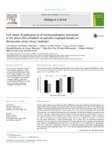Por favor, use este identificador para citar o enlazar este ítem:
http://www.alice.cnptia.embrapa.br/alice/handle/doc/976424Registro completo de metadatos
| Campo DC | Valor | Lengua/Idioma |
|---|---|---|
| dc.contributor.author | MONTEIRO, C. M. DE O. | pt_BR |
| dc.contributor.author | MATOS, R. DA S. | pt_BR |
| dc.contributor.author | ARAÚJO, L. X. | pt_BR |
| dc.contributor.author | PERINOTTO, W. M. DE S. | pt_BR |
| dc.contributor.author | BITTENCOURT, V. R. E. P. | pt_BR |
| dc.contributor.author | DOLINSKI, C. | pt_BR |
| dc.contributor.author | PRATA, M. C. de A. | pt_BR |
| dc.date.accessioned | 2014-07-26T06:55:43Z | - |
| dc.date.available | 2014-07-26T06:55:43Z | - |
| dc.date.created | 2014-01-16 | pt_BR |
| dc.date.issued | 2014 | pt_BR |
| dc.identifier.citation | Biological Control, v. 69, p. 78-81, 2014. | pt_BR |
| dc.identifier.uri | http://www.alice.cnptia.embrapa.br/alice/handle/doc/976424 | pt_BR |
| dc.description | The aim of this study was to evaluate the effect of different concentrations of the entomopathogenic nematodes (EPNs) Heterorhabditis bacteriophora HP88 and Heterorhabditis indica LPP1 on the reproductive biology of partially engorged females of Dermacentor nitens. Four groups were formed, with each group containing 10 females and exposed to concentrations of 0, 75, 300, and 1200 nematodes for each female. This procedure was performed separately for each nematode. The following biological parameters were evaluated: egg mass weight, egg production index, hatching percentage, and percentage of control. H. bacteriophora HP88 at the two highest concentrations (300 and 1200 EPNs/female) caused a reduction (p < 0.05) on the egg mass and egg production index. Was noted a significant reduction (p < 0.05) in the percentage of hatched in all the treated groups. For H. indica LPP1, all treatments resulted in decreased (p < 0.05) values for all the parameters. The percentages of controls obtained at concentrations of 75, 300, and 1200 EPNs/female were 56.3, 89.3, and 98.8 and 77.5, 77.1, and 95.9 for H. bacteriophora HP88 and H. indica LPP1, respectively. Therefore, it is concluded that these nematodes showed pathogenicity toward partially engorged females of D. nitens, thereby negatively affecting the reproductive biology of this tick. | eng |
| dc.language.iso | eng | eng |
| dc.rights | openAccess | eng |
| dc.subject | Nematoides | pt_BR |
| dc.subject | Femeas parcialmente engorgitadas | pt_BR |
| dc.title | First report of pathogenicity of entomopathogenic nematodes of the genus Heterorhabditis on partially engorged females of Dermacentor nitens (Acari: Ixodidae). | pt_BR |
| dc.type | Artigo de periódico | pt_BR |
| dc.date.updated | 2014-07-26T06:55:43Z | pt_BR |
| riaa.ainfo.id | 976424 | pt_BR |
| riaa.ainfo.lastupdate | 2014-07-25 | pt_BR |
| dc.contributor.institution | CAIO MÁRCIO DE OLIVEIRA MONTEIRO, UFRRJ; RENATA DA SILVA MATOS, UFJF; LARISSA XAVIER ARAÚJO, UFJF; WENDELL MARCELO DE SOUZA PERINOTTO, UFRRJ; VANIA RITA ELIAS PINHEIRO BITTENCOURT, UFRRJ; CLÁUDIA DOLINSKI, UENF; MARCIA CRISTINA DE AZEVEDO PRATA, CNPGL. | pt_BR |
| Aparece en las colecciones: | Artigo em periódico indexado (CNPGL)  | |
Ficheros en este ítem:
| Fichero | Descripción | Tamaño | Formato | |
|---|---|---|---|---|
| ArtigoMarcia1s2.0S1049964413002624main.pdf | 315.98 kB | Adobe PDF |  Visualizar/Abrir |









